数组
数组的底层结构

数组删除元素

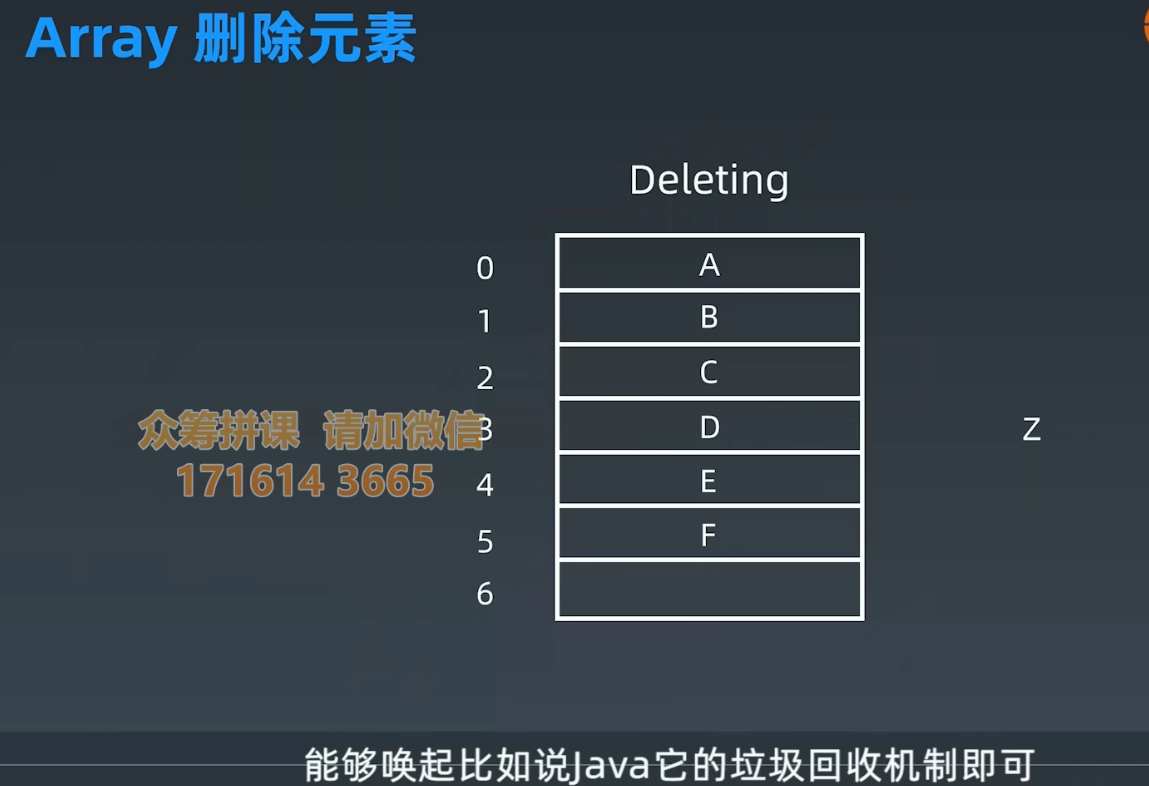
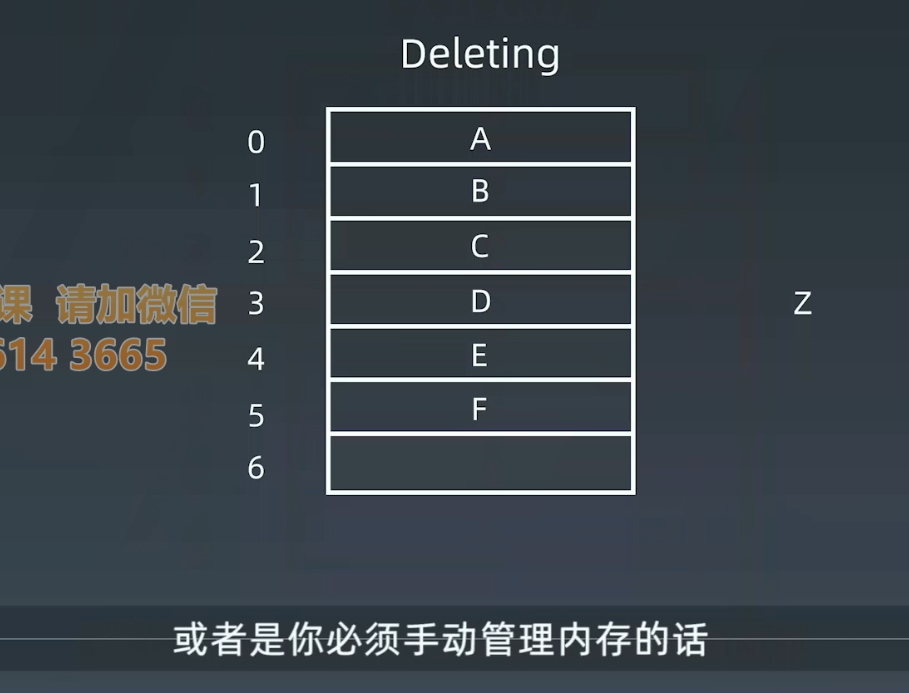
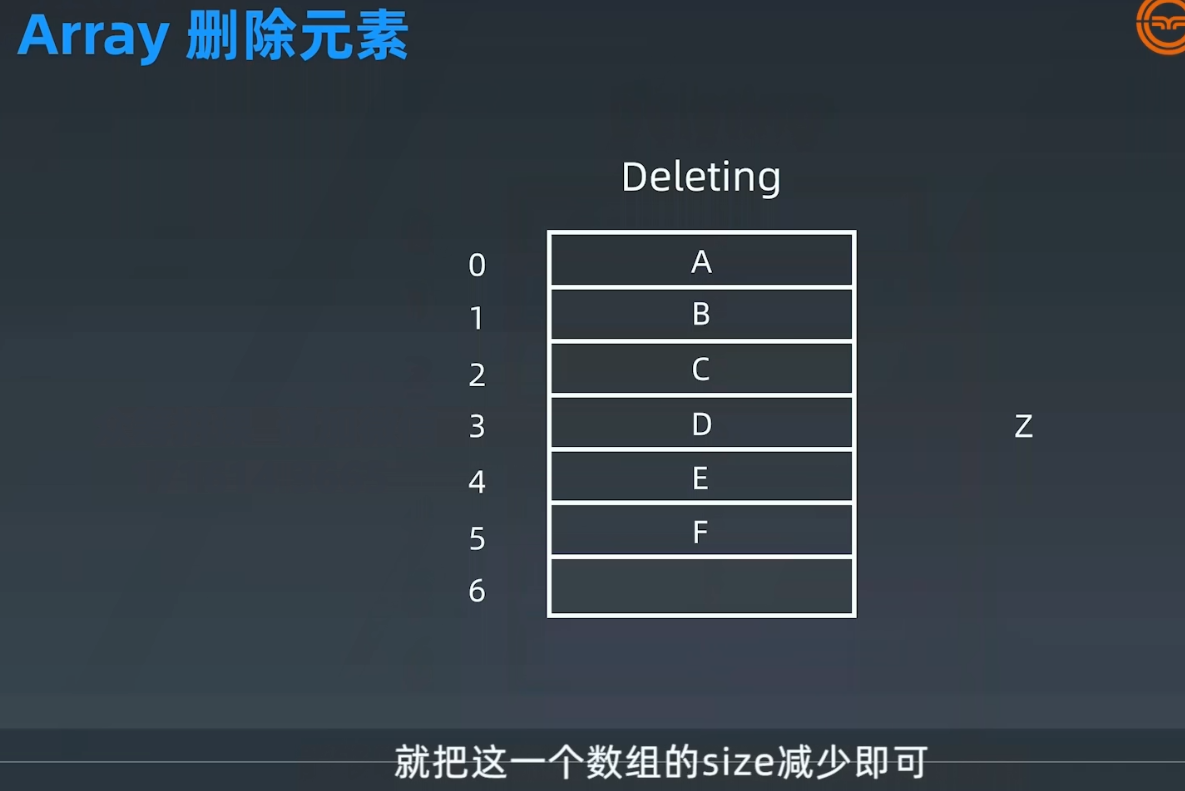
ArrayList
http://developer.classpath.org/doc/java/util/ArrayList-source.html
add()
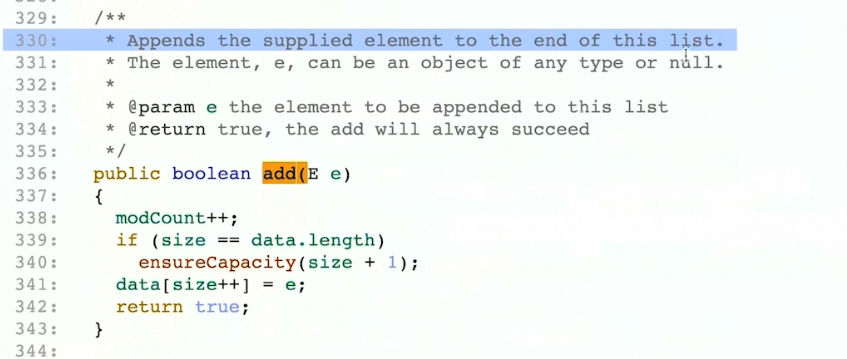


ensureCapacity()
如果minCapacity长度不够,新的数组的长度为当前的长度再乘以2,然后把旧数组的值拷贝到新数组里面,返回一个新数组
170: public void ensureCapacity(int minCapacity)
171: {
172: int current = data.length;
173:
174: if (minCapacity > current)
175: {
176: E[] newData = (E[]) new Object[Math.max(current * 2, minCapacity)];
177: System.arraycopy(data, 0, newData, 0, size);
178: data = newData;
179: }
180: }
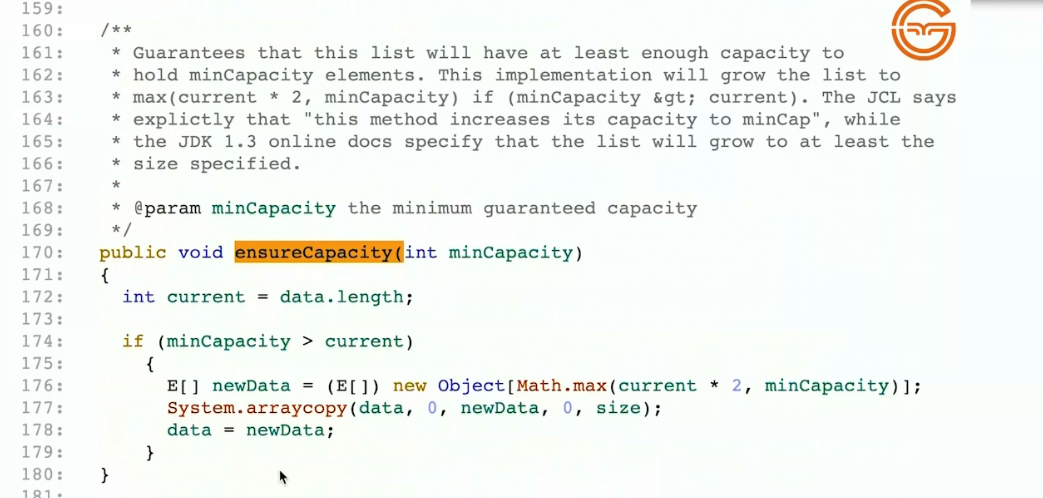
时间复杂度
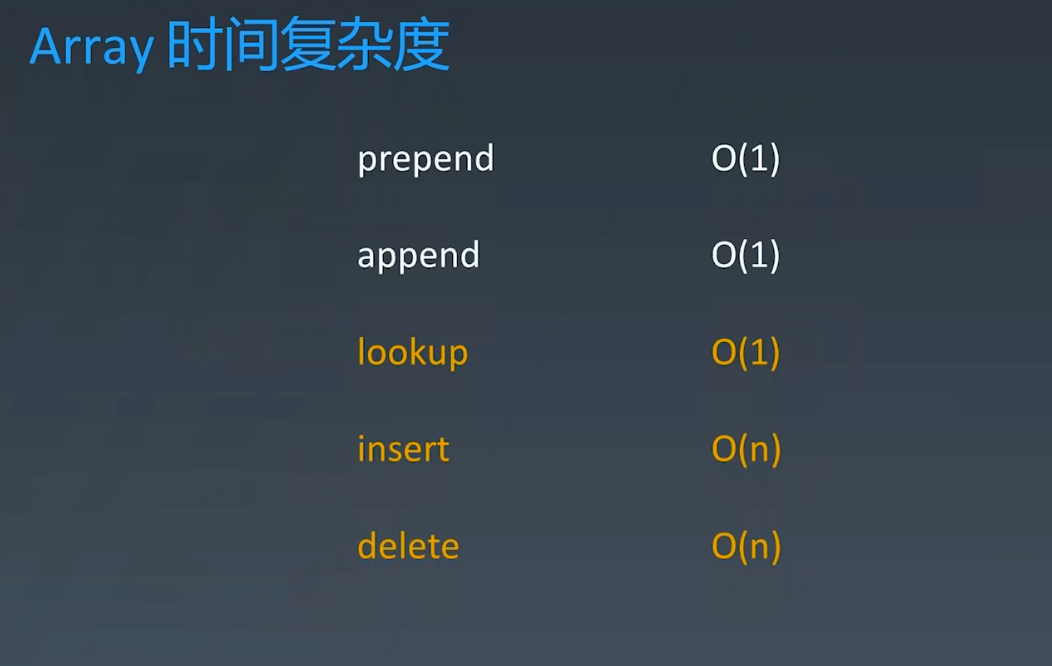
问题
如果对ArrayList大量的修改,会涉及大量的数组复制问题,时间复杂度会很大
Linked list
链表数据结构,它的每一个元素,一般用class来定义,这个class称之为node,里面有两个成员变量,value和next指针

代码实现
代码实现1
https://www.geeksforgeeks.org/implementing-a-linked-list-in-java-using-class/
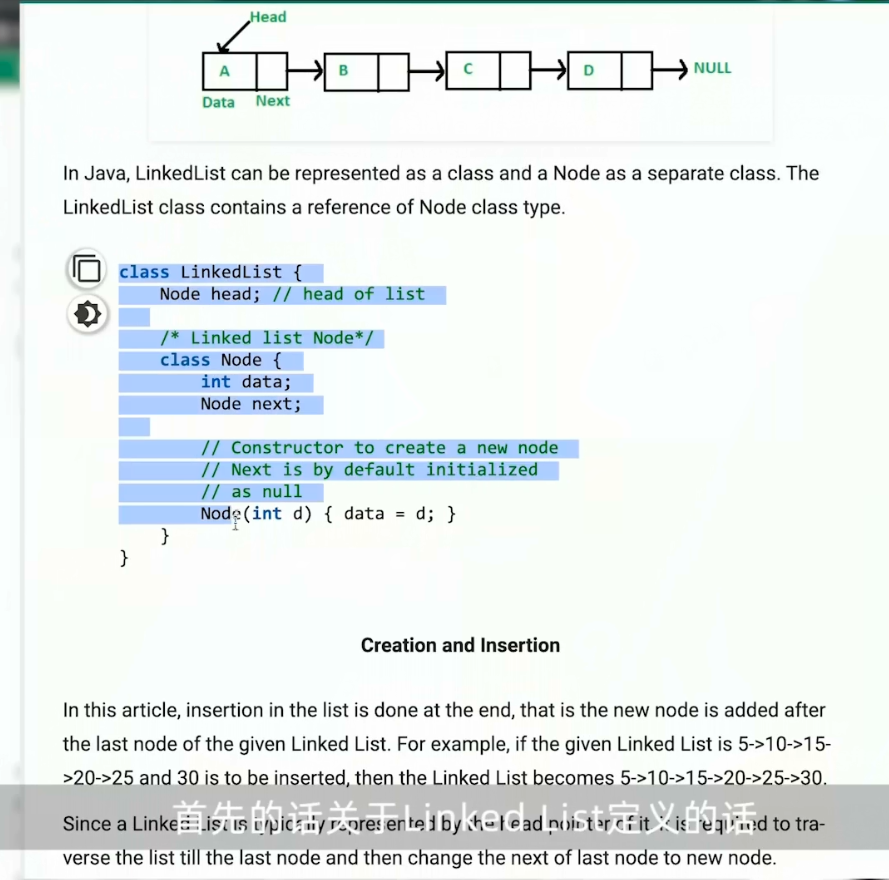
代码实现2
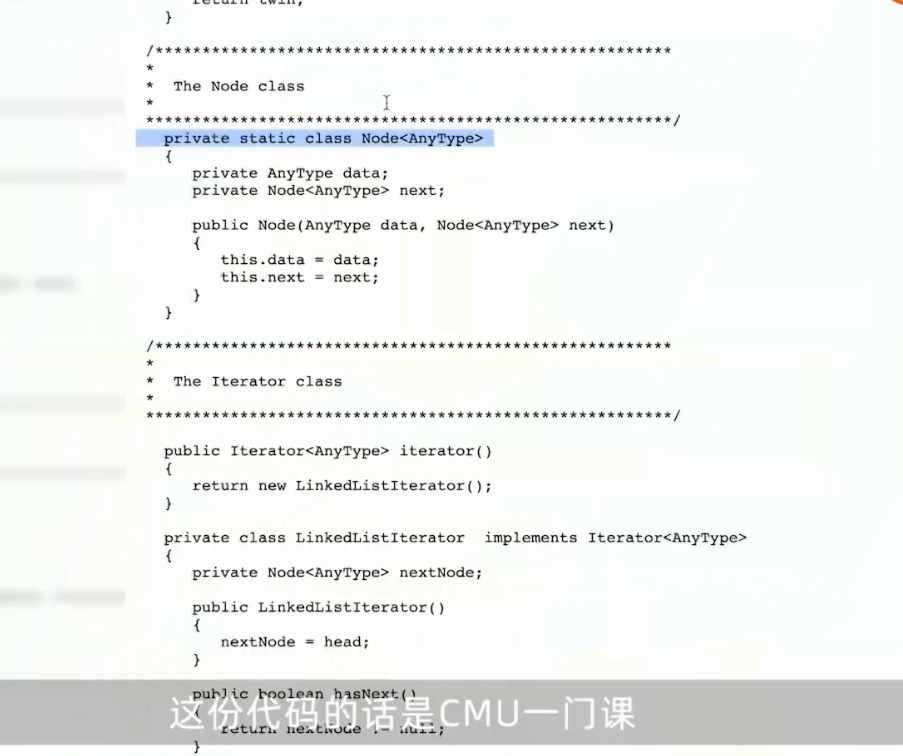
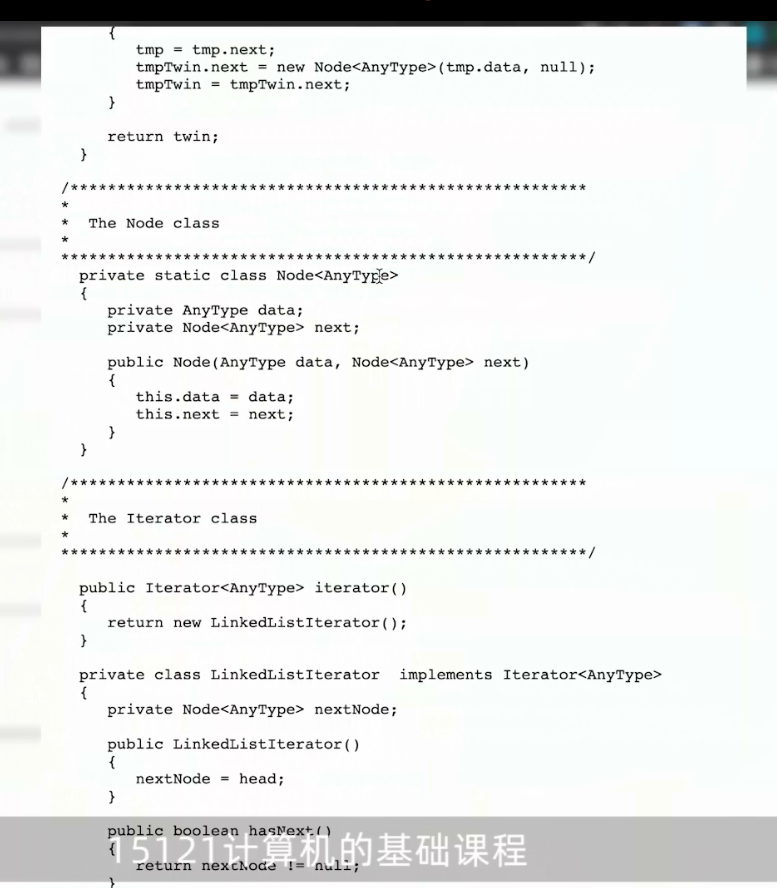
/***************************************************************************
* A Linked List class with a private static inner Node class.
*
*****************************************************************************/
import java.util.*;
public class LinkedList<AnyType> implements Iterable<AnyType>
{
private Node<AnyType> head;
/**
* Constructs an empty list
*/
public LinkedList()
{
head = null;
}
/**
* Returns true if the list is empty
*
*/
public boolean isEmpty()
{
return head == null;
}
/**
* Inserts a new node at the beginning of this list.
*
*/
public void addFirst(AnyType item)
{
head = new Node<AnyType>(item, head);
}
/**
* Returns the first element in the list.
*
*/
public AnyType getFirst()
{
if(head == null) throw new NoSuchElementException();
return head.data;
}
/**
* Removes the first element in the list.
*
*/
public AnyType removeFirst()
{
AnyType tmp = getFirst();
head = head.next;
return tmp;
}
/**
* Inserts a new node to the end of this list.
*
*/
public void addLast(AnyType item)
{
if( head == null)
addFirst(item);
else
{
Node<AnyType> tmp = head;
while(tmp.next != null) tmp = tmp.next;
tmp.next = new Node<AnyType>(item, null);
}
}
/**
* Returns the last element in the list.
*
*/
public AnyType getLast()
{
if(head == null) throw new NoSuchElementException();
Node<AnyType> tmp = head;
while(tmp.next != null) tmp = tmp.next;
return tmp.data;
}
/**
* Removes all nodes from the list.
*
*/
public void clear()
{
head = null;
}
/**
* Returns true if this list contains the specified element.
*
*/
public boolean contains(AnyType x)
{
for(AnyType tmp : this)
if(tmp.equals(x)) return true;
return false;
}
/**
* Returns the data at the specified position in the list.
*
*/
public AnyType get(int pos)
{
if (head == null) throw new IndexOutOfBoundsException();
Node<AnyType> tmp = head;
for (int k = 0; k < pos; k++) tmp = tmp.next;
if( tmp == null) throw new IndexOutOfBoundsException();
return tmp.data;
}
/**
* Returns a string representation
*
*/
public String toString()
{
StringBuffer result = new StringBuffer();
for(Object x : this)
result.append(x + " ");
return result.toString();
}
/**
* Inserts a new node after a node containing the key.
*
*/
public void insertAfter(AnyType key, AnyType toInsert)
{
Node<AnyType> tmp = head;
while(tmp != null && !tmp.data.equals(key)) tmp = tmp.next;
if(tmp != null)
tmp.next = new Node<AnyType>(toInsert, tmp.next);
}
/**
* Inserts a new node before a node containing the key.
*
*/
public void insertBefore(AnyType key, AnyType toInsert)
{
if(head == null) return;
if(head.data.equals(key))
{
addFirst(toInsert);
return;
}
Node<AnyType> prev = null;
Node<AnyType> cur = head;
while(cur != null && !cur.data.equals(key))
{
prev = cur;
cur = cur.next;
}
//insert between cur and prev
if(cur != null)
prev.next = new Node<AnyType>(toInsert, cur);
}
/**
* Removes the first occurrence of the specified element in this list.
*
*/
public void remove(AnyType key)
{
if(head == null)
throw new RuntimeException("cannot delete");
if( head.data.equals(key) )
{
head = head.next;
return;
}
Node<AnyType> cur = head;
Node<AnyType> prev = null;
while(cur != null && !cur.data.equals(key) )
{
prev = cur;
cur = cur.next;
}
if(cur == null)
throw new RuntimeException("cannot delete");
//delete cur node
prev.next = cur.next;
}
/**
* Returns a deep copy of the list
* Complexity: O(n^2)
*/
public LinkedList<AnyType> copy1()
{
LinkedList<AnyType> twin = new LinkedList<AnyType>();
Node<AnyType> tmp = head;
while(tmp != null)
{
twin.addLast( tmp.data );
tmp = tmp.next;
}
return twin;
}
/**
* Returns a deep copy of the list
* Complexity: O(n)
*/
public LinkedList<AnyType> copy2()
{
LinkedList<AnyType> twin = new LinkedList<AnyType>();
Node<AnyType> tmp = head;
while(tmp != null)
{
twin.addFirst( tmp.data );
tmp = tmp.next;
}
return twin.reverse();
}
/**
* Reverses the list
* Complewxity: O(n)
*/
public LinkedList<AnyType> reverse()
{
LinkedList<AnyType> list = new LinkedList<AnyType>();
Node<AnyType> tmp = head;
while(tmp != null)
{
list.addFirst( tmp.data );
tmp = tmp.next;
}
return list;
}
/**
* Returns a deep copy of the immutable list
* It uses a tail reference.
* Complexity: O(n)
*/
public LinkedList<AnyType> copy3()
{
LinkedList<AnyType> twin = new LinkedList<AnyType>();
Node<AnyType> tmp = head;
if(head==null) return null;
twin.head = new Node<AnyType>(head.data, null);
Node<AnyType> tmpTwin = twin.head;
while(tmp.next != null)
{
tmp = tmp.next;
tmpTwin.next = new Node<AnyType>(tmp.data, null);
tmpTwin = tmpTwin.next;
}
return twin;
}
/*******************************************************
*
* The Node class
*
********************************************************/
private static class Node<AnyType>
{
private AnyType data;
private Node<AnyType> next;
public Node(AnyType data, Node<AnyType> next)
{
this.data = data;
this.next = next;
}
}
/*******************************************************
*
* The Iterator class
*
********************************************************/
public Iterator<AnyType> iterator()
{
return new LinkedListIterator();
}
private class LinkedListIterator implements Iterator<AnyType>
{
private Node<AnyType> nextNode;
public LinkedListIterator()
{
nextNode = head;
}
public boolean hasNext()
{
return nextNode != null;
}
public AnyType next()
{
if (!hasNext()) throw new NoSuchElementException();
AnyType res = nextNode.data;
nextNode = nextNode.next;
return res;
}
public void remove() { throw new UnsupportedOperationException(); }
}
/***** Include the main() for testing and debugging *****/
public static void main(String[] args)
{
LinkedList<String> list = new LinkedList <String>();
list.addFirst("p");
list.addFirst("a");
list.addFirst("e");
list.addFirst("h");
System.out.println(list);
LinkedList<String> twin = list.copy3();
System.out.println(twin);
System.out.println(list.get(0));
// System.out.println(list.get(4)); //exception
list.addLast("s");
Iterator itr = list.iterator();
while(itr.hasNext())
System.out.print(itr.next() + " ");
System.out.println();
for(Object x : list)
System.out.print(x + " ");
System.out.println();
list.insertAfter("e", "ee");
System.out.println(list);
System.out.println(list.getLast());
list.insertBefore("h", "yy");
System.out.println(list);
list.remove("p");
System.out.println(list);
}
}
LinkedList(java)
双向链表
entry
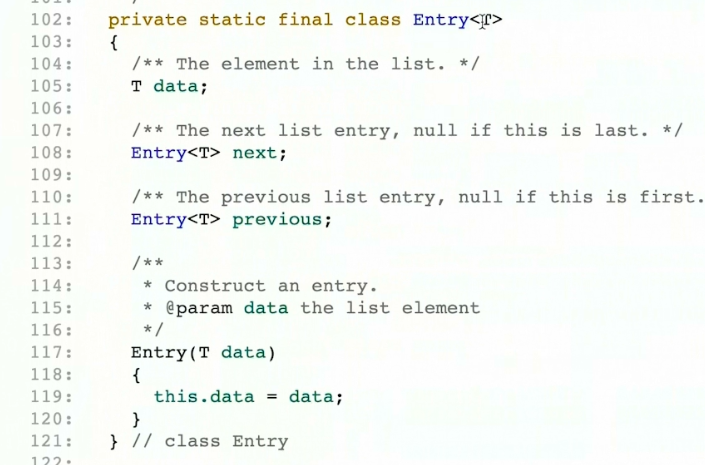
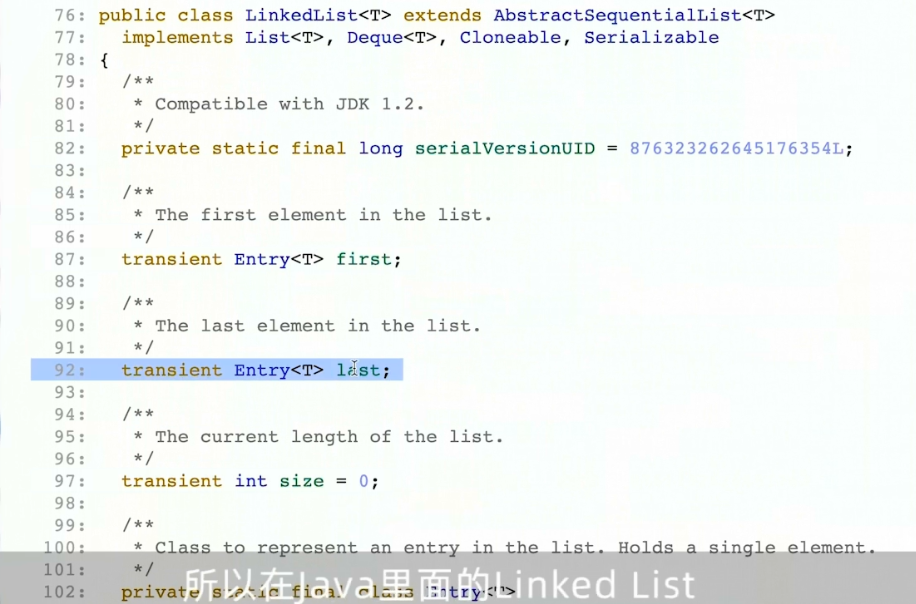
添加和删除
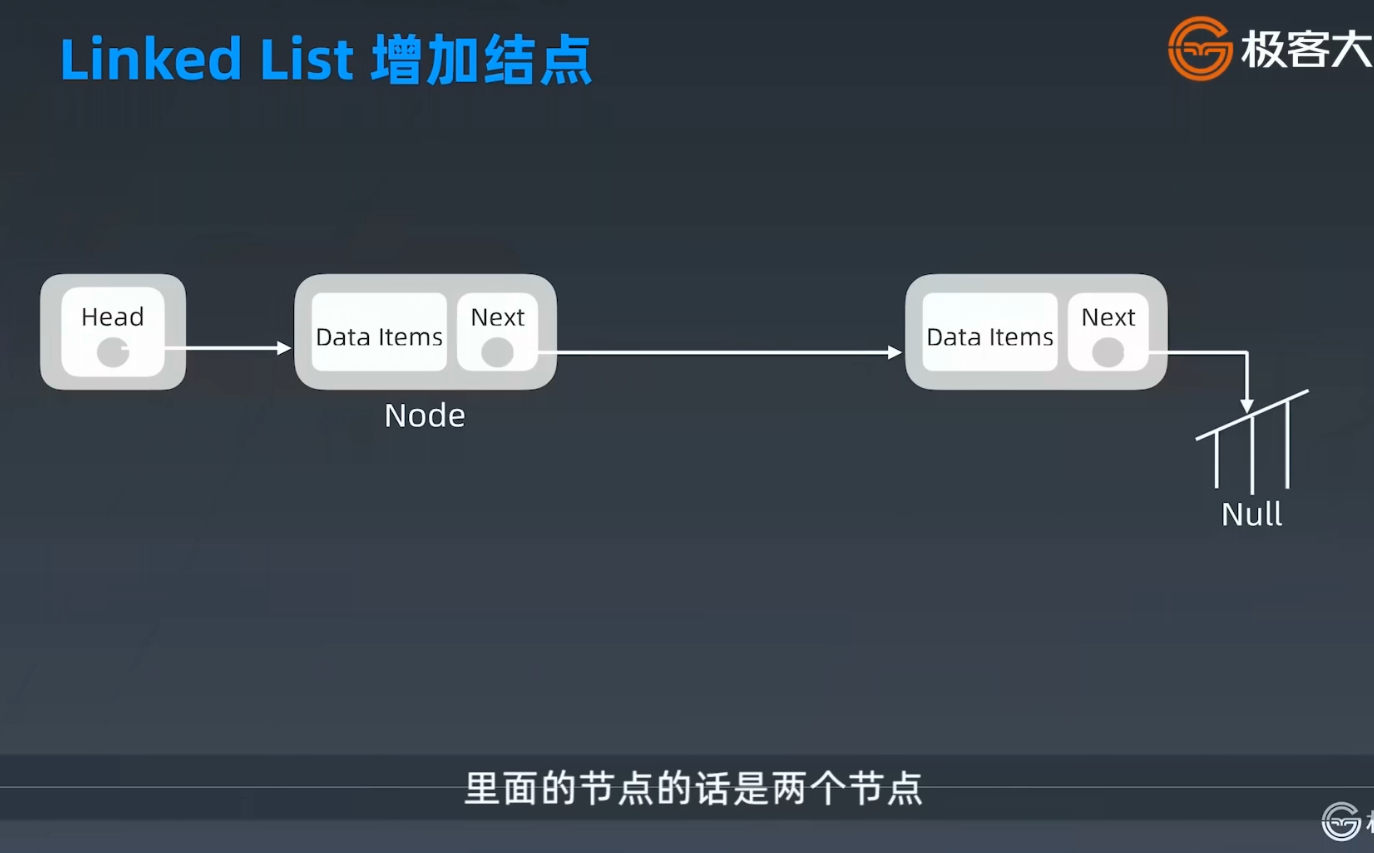
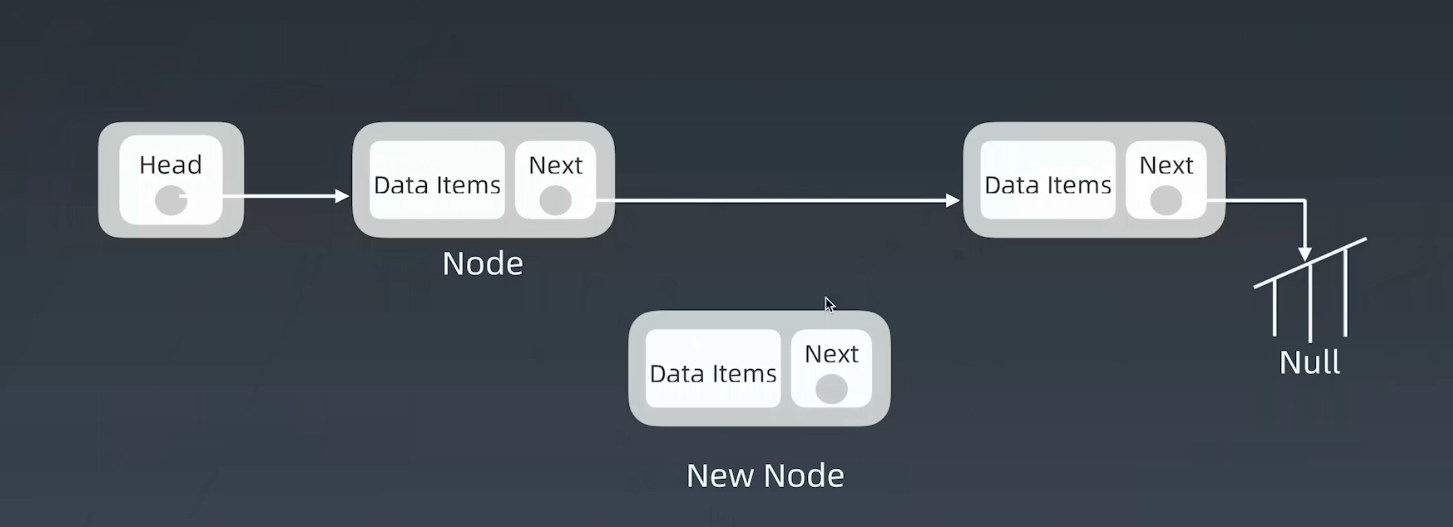




访问
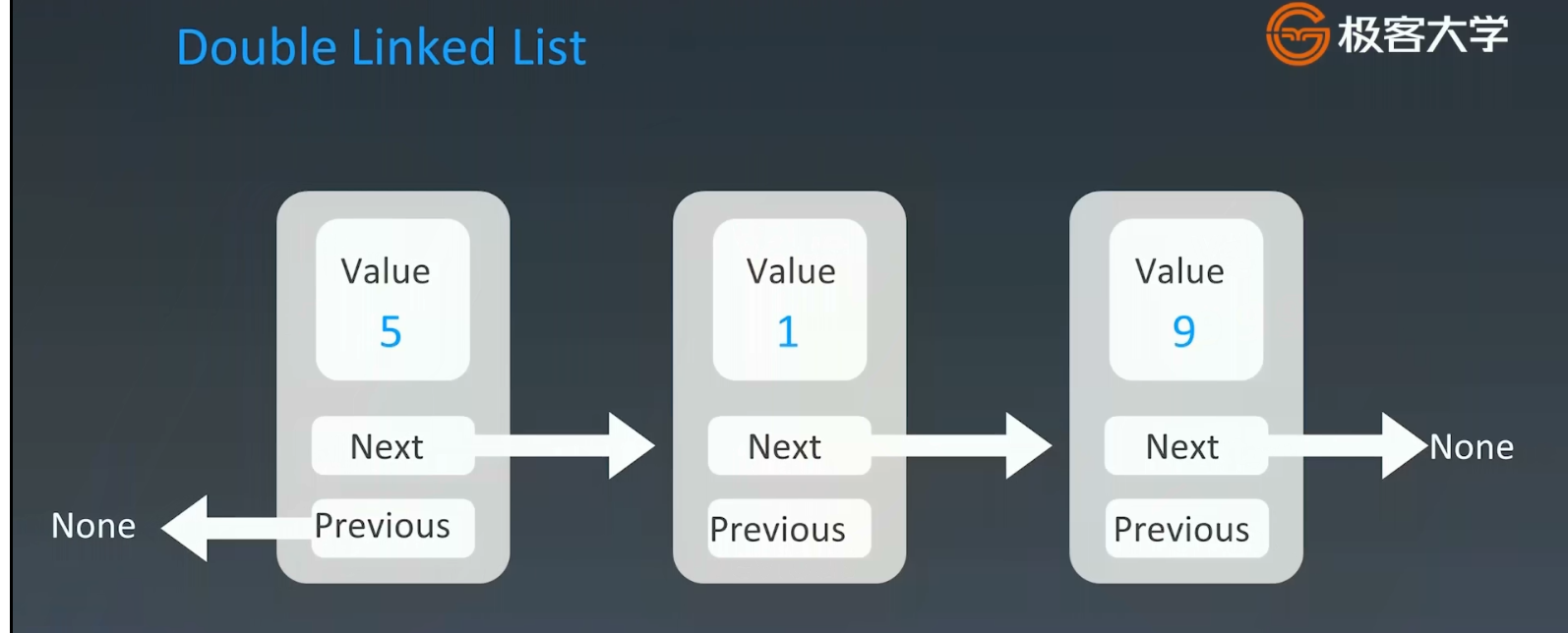
时间复杂度
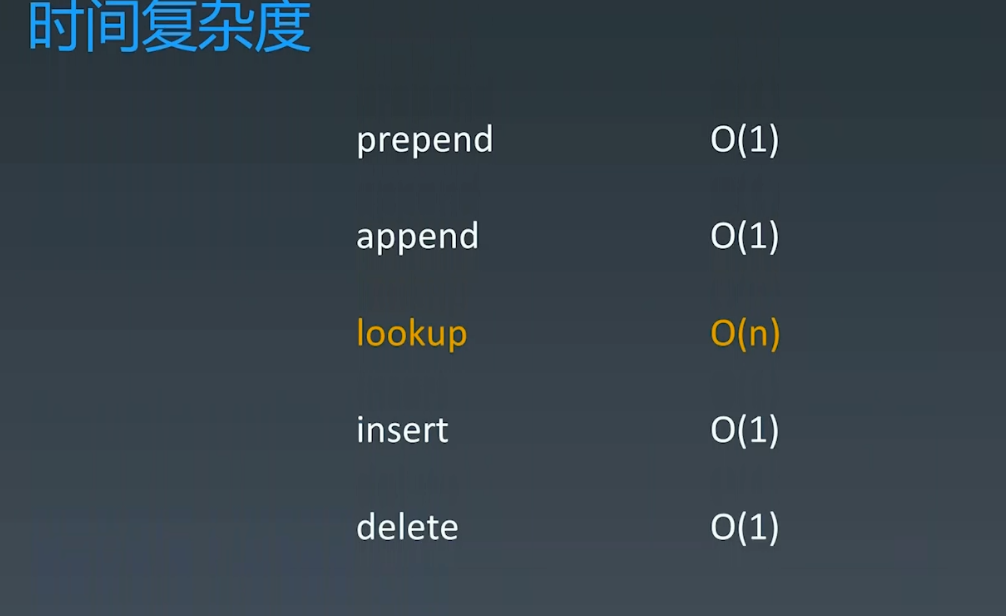
Skip List 跳表
比较

链表加速

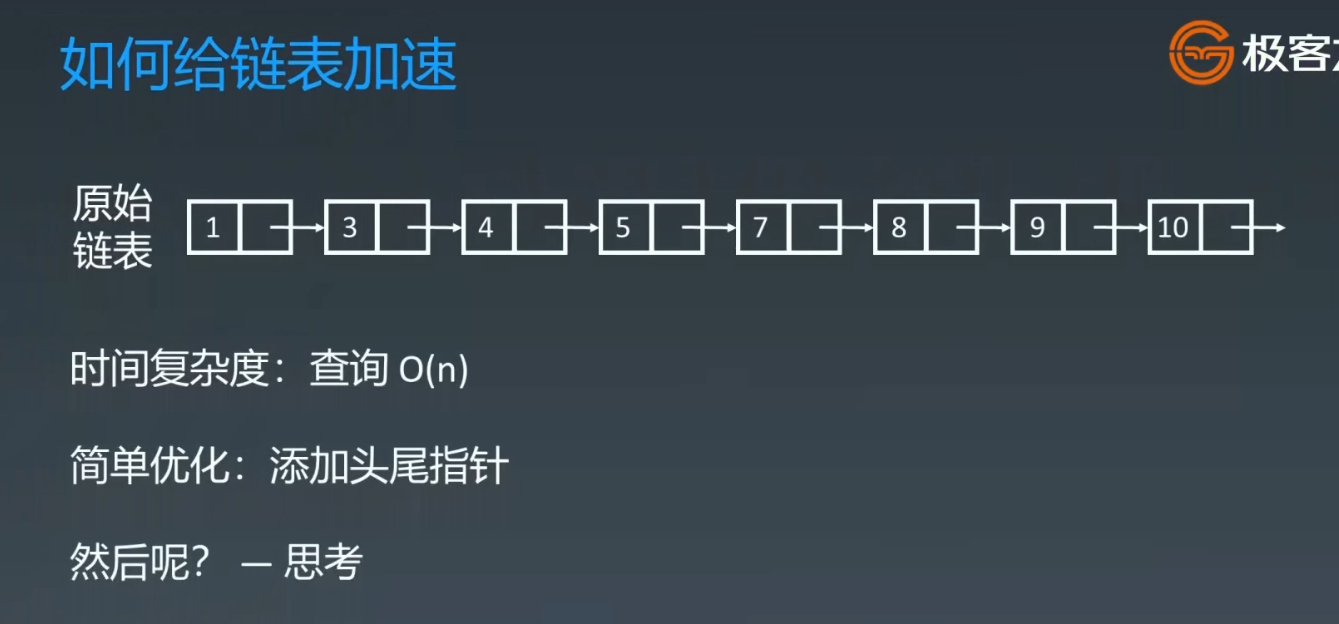
跳表的实现

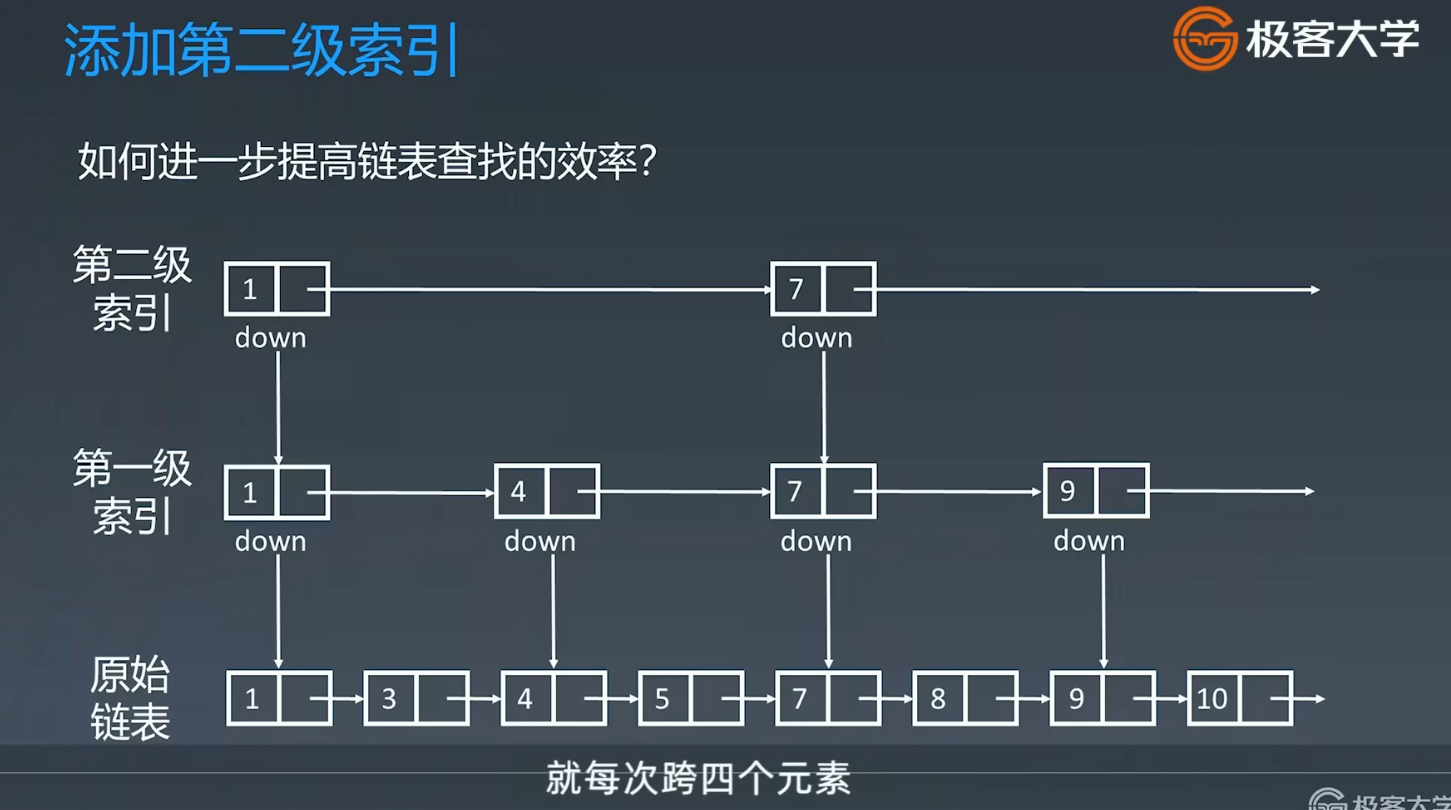
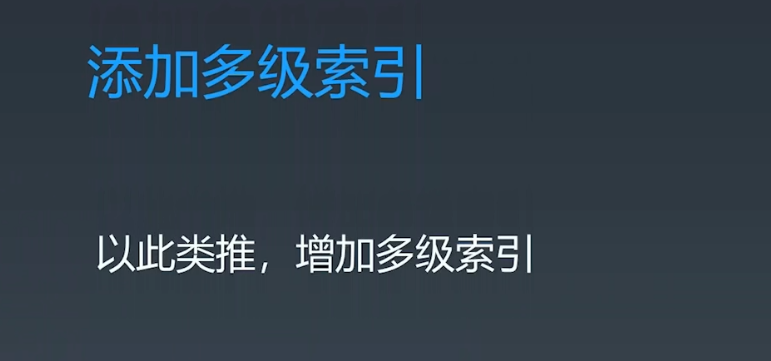
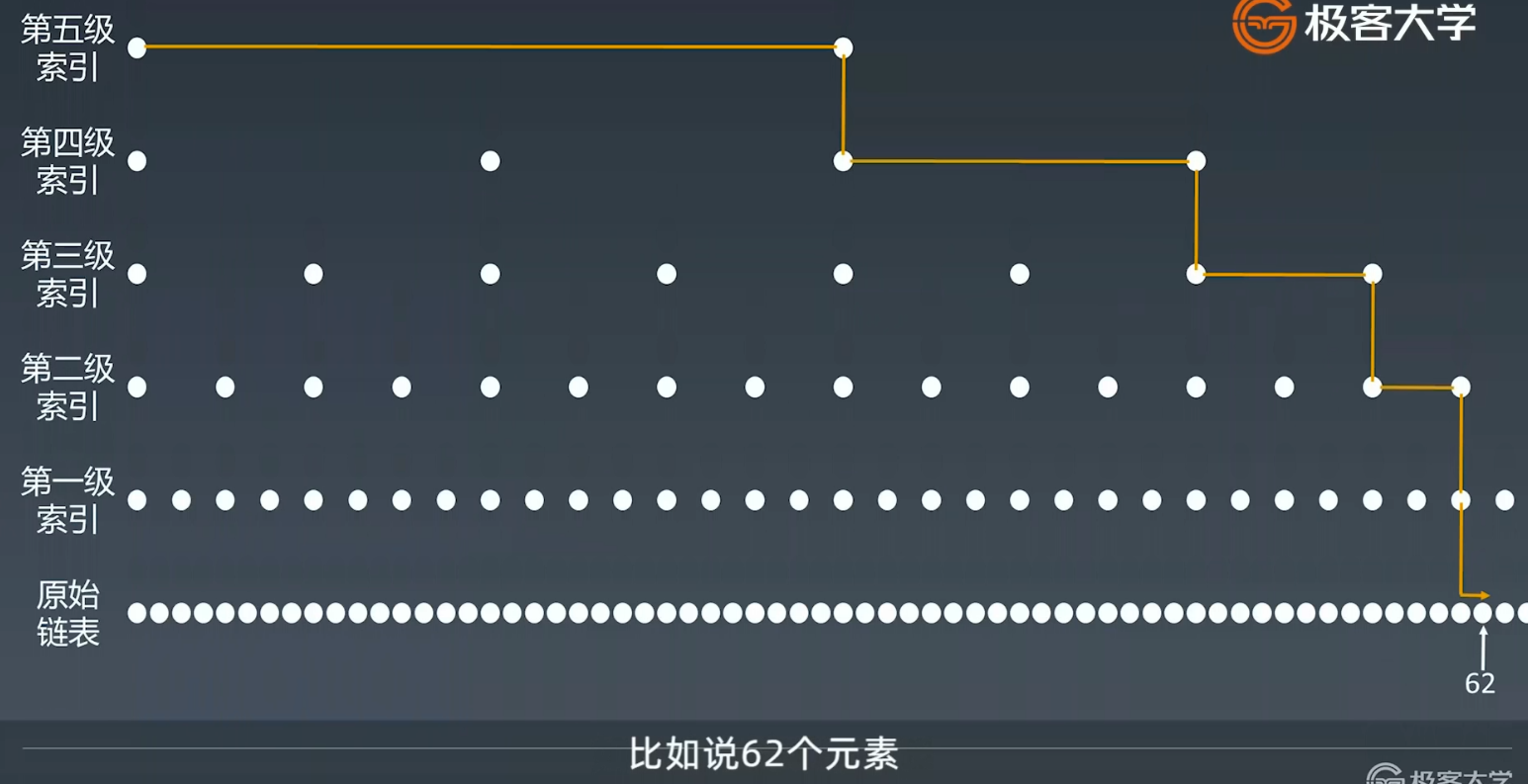
增加的数量 log2n
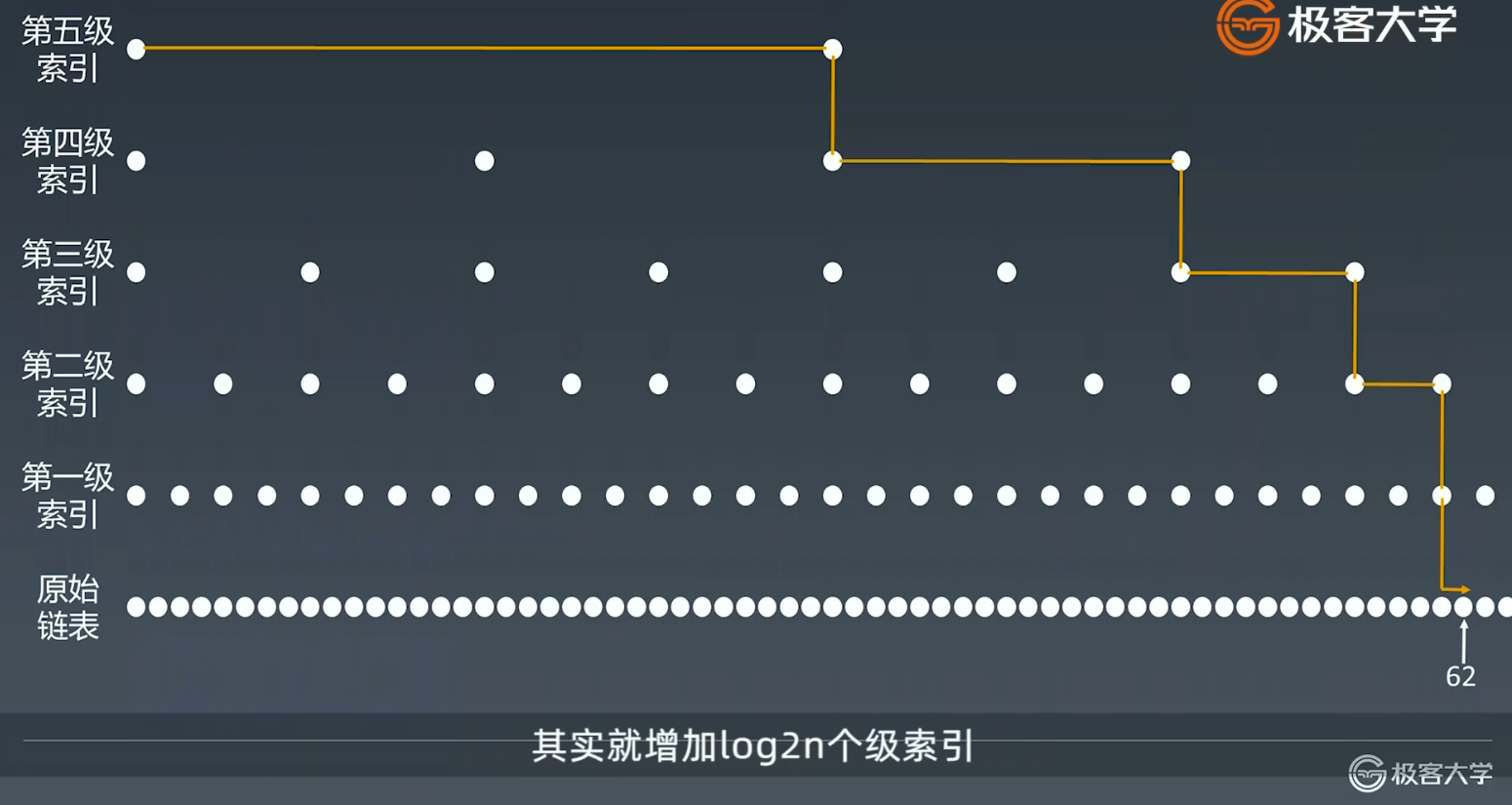
时间复杂度

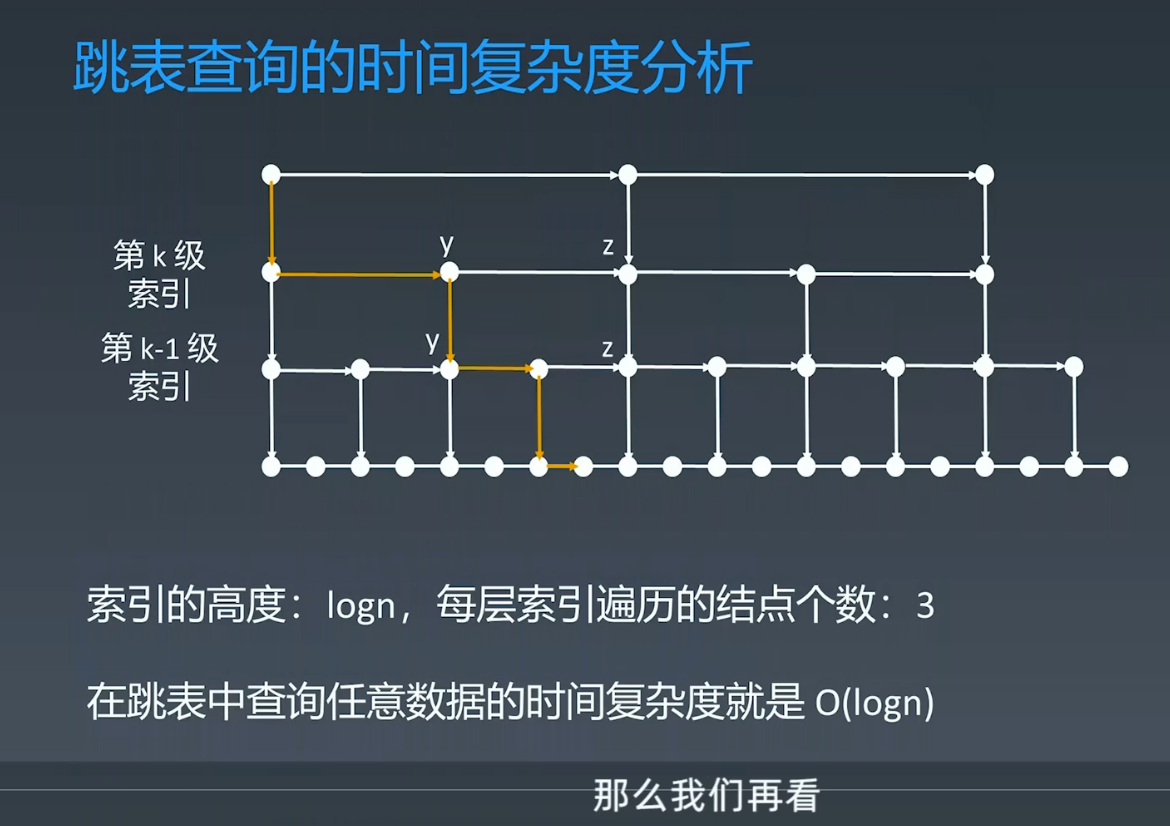
现实中跳表的形态
索引随着元素更新而更新
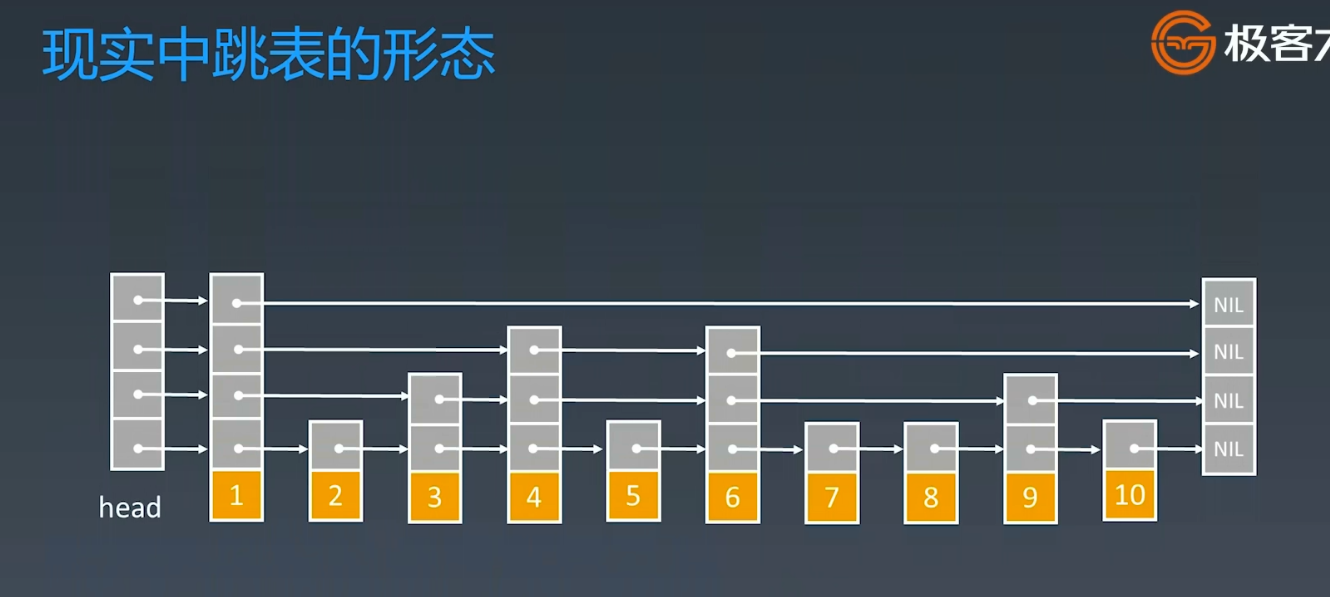
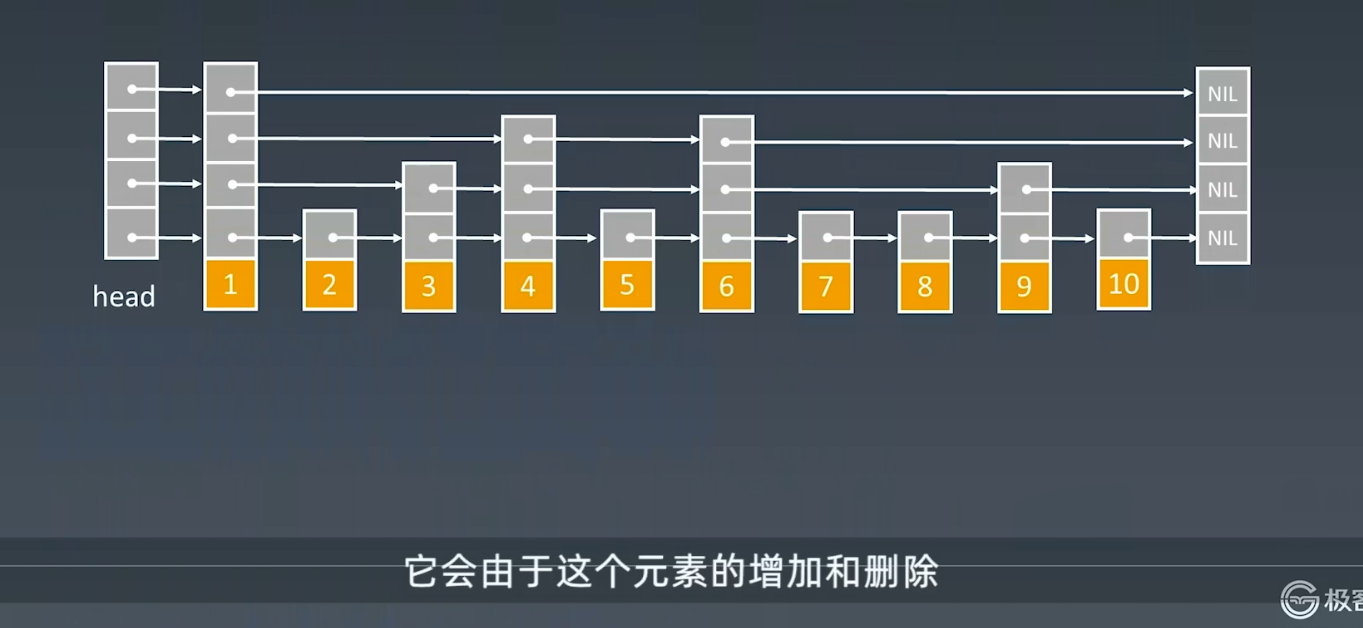
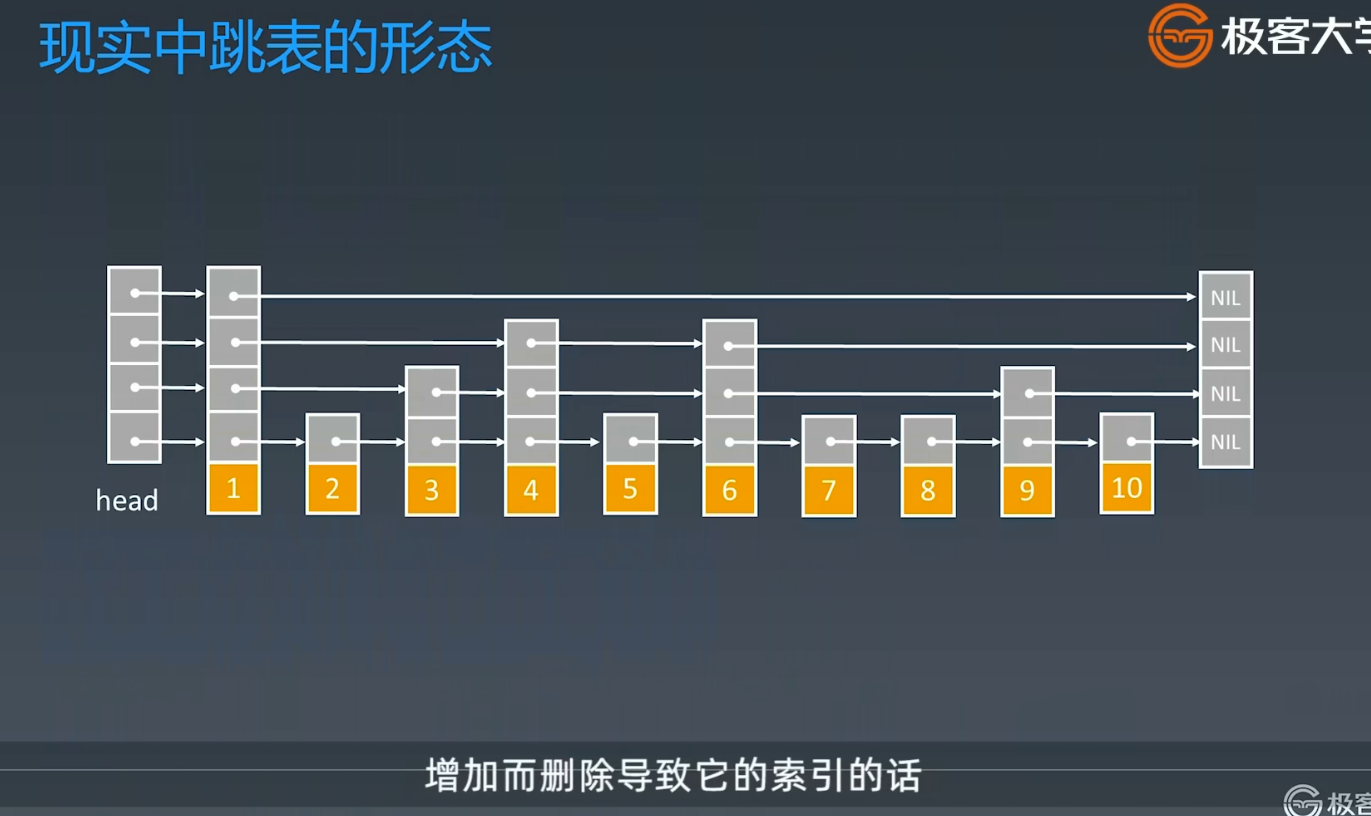
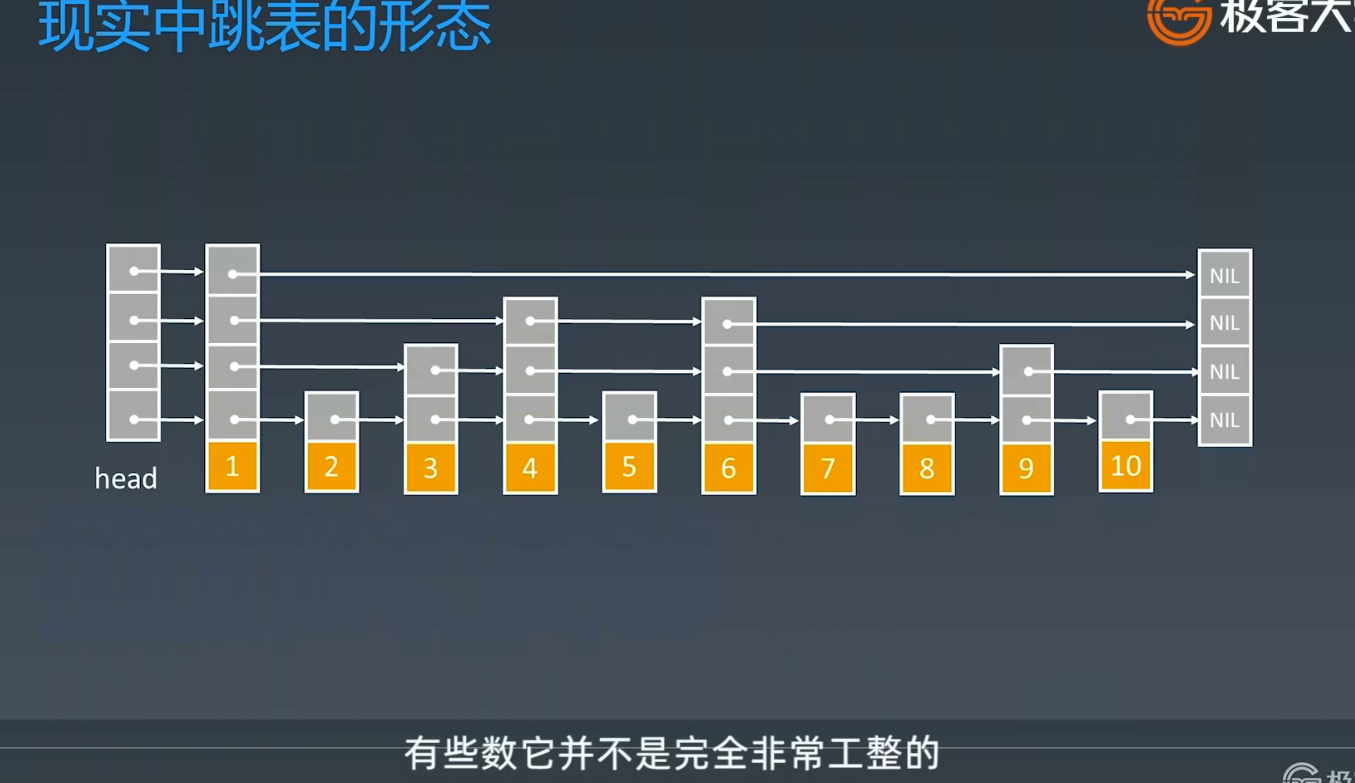
空间复杂度
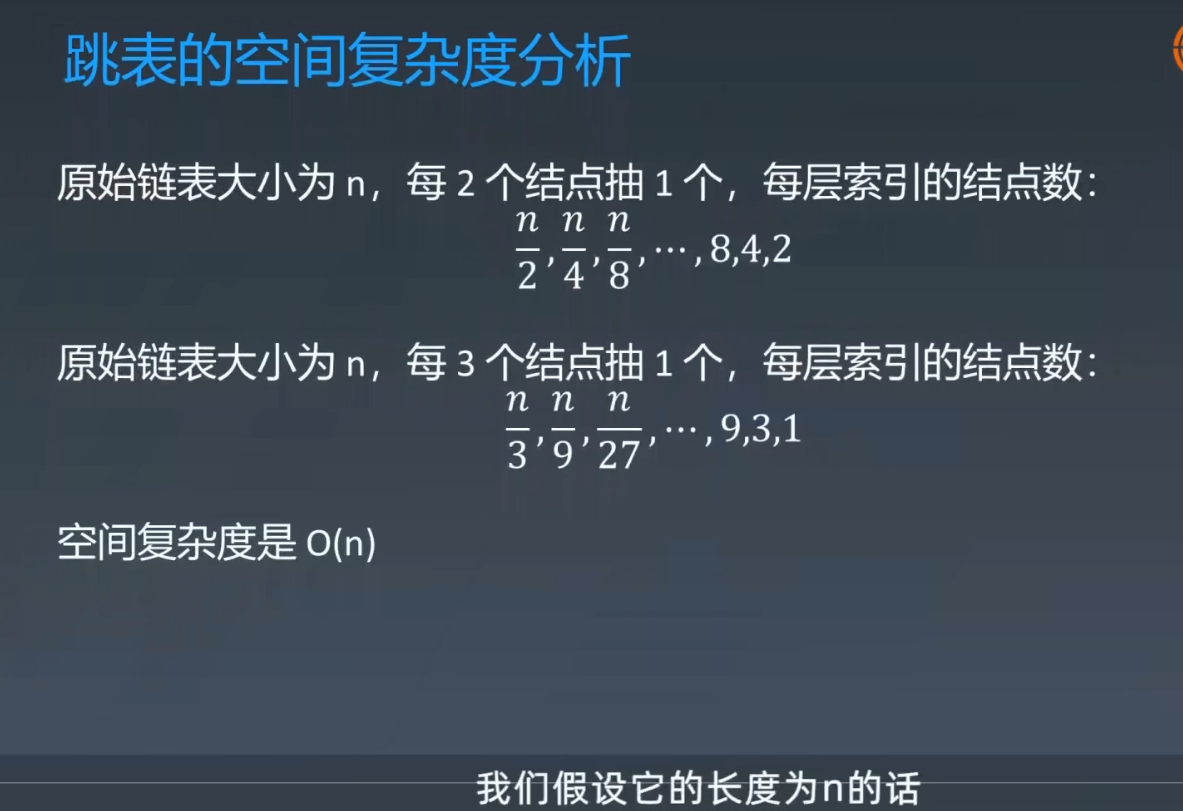
工程中的应用
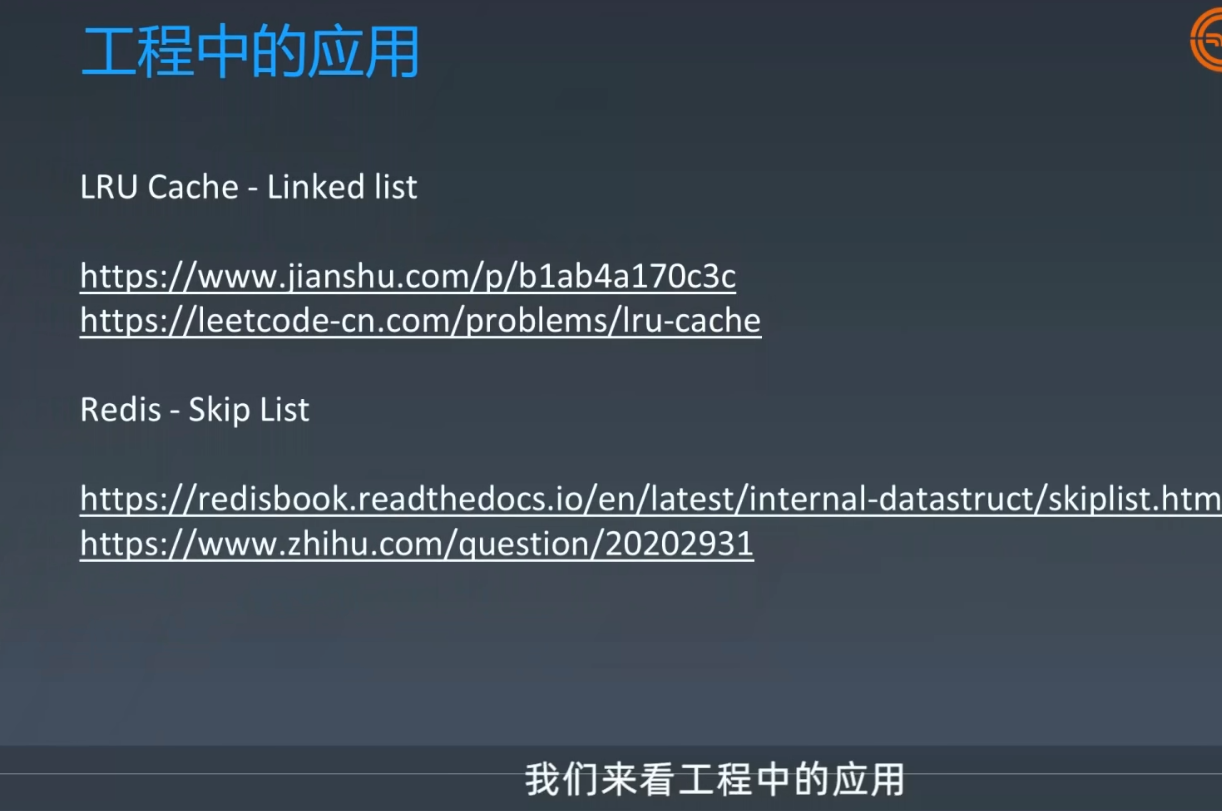
LRU Cache - Linked list
https://www.jianshu.com/p/b1ab4a170c3c
https://leetcode-cn.com/problems/lru-cache/
Redis - Skip List
https://redisbook.readthedocs.io/en/latest/internal-datastruct/skiplist.html
https://www.zhihu.com/question/20202931
小结
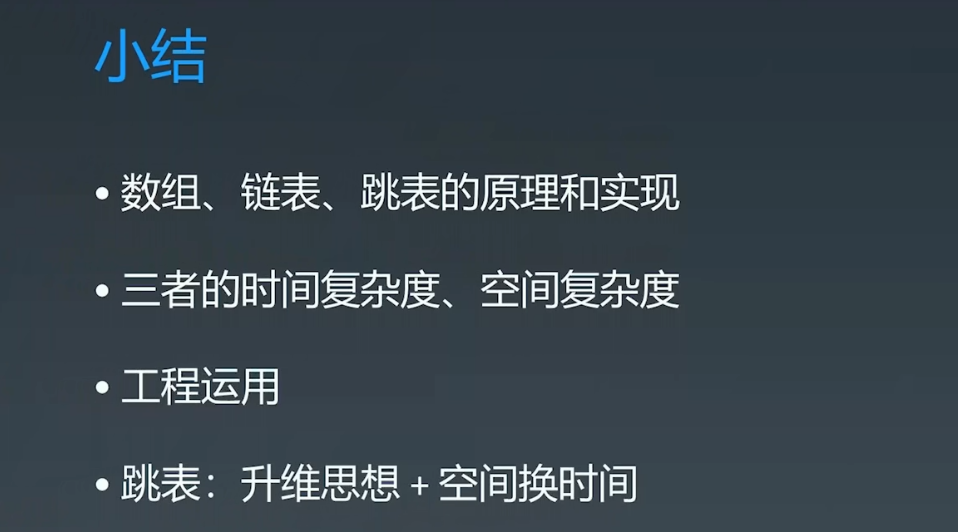






















 3814
3814











 被折叠的 条评论
为什么被折叠?
被折叠的 条评论
为什么被折叠?








